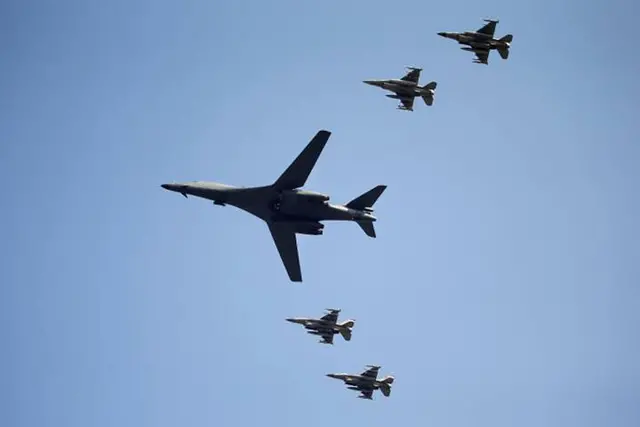The U.S. military on Tuesday flew two nuclear-capable supersonic bombers over South Korea in a show of force following the Democratic People's Republic of Korea (DPRK) 's recent nuclear test.
Two B-1B Lancers, which can carry nuclear weapons, flew over the Osan Air Base in Pyeongtaek, some 70 km south of capital Seoul, at about 10 a.m. local time (0100GMT).
The one was flanked by four South Korean F-15K fighter jets, while the other was joined by four U.S. F-16 fighter planes before returning to the base. The high-speed bombers made a sortie from the U.S. air base in Guam.
U.S. Forces Korea (USFK) said in an emailed statement that the flyover highlights the close cooperation between U.S. and South Korean military forces that keep them ready to respond at any time to threats to stability and security.
The flights are a day later than scheduled. The United States reportedly planned to send the bombers to South Korea on Monday, but it was delayed due to unfavorable weather conditions.
The U.S. allegedly forward-deployed several B-1Bs to Andersen base in Guam in early August from Ellsworth air base in South Dakota to replace B-52 strategic bombers.
Three B-2 stealth bombers also arrived in Guam last month from Whiteman base in Missouri. It was the first time that the U.S. strategic bomber trio was mobilized together in the Pacific region.
The DPRK had denounced the forward-deployment of U.S. nuclear-capable bombers, saying it was an evidence to show the U.S. intention of pre-emptive nuclear strikes against Pyongyang.
The flight of B-1Bs over South Korean territory near the inter- Korean border came just four days after the DPRK announced its successful explosion test of nuclear warhead that can be mounted on ballistic missiles.
South Korea's military estimated the fifth nuclear test was the most powerful as it produced an explosive yield of 10 kilotons, bigger than 6 kilotons generated in the previous test.
Following the Jan. 6 nuclear detonation, the fourth from the DPRK, the U.S. military staged an armed protest by flying a B-52 strategic bomber over the Osan Air Base.
In early 2013, the U.S. flew nuclear-capable B-2s, B-52s and F- 22 fighter jets close to the inter-Korean border. In February of the year, Pyongyang carried out its third atomic device test.
"Today's demonstration provides just one example of the full range of military capabilities in the deep resources of this strong alliance to provide and strengthen extended deterrence," said Gen. Vincent K. Brooks, USFK commander, indicating further mobilization of U.S. strategic assets on the Korean peninsula.
The U.S. deployment of its nuclear-capable bomber trio in the Pacific escalates the already heightened tensions in the region, which is one the world's most-armed powder kegs.
The B-1B, which went into operation in 1980s, is known to be capable of carrying as heavy as 61 tons of weapons, including 24 nuclear bombs as well as 24 joint direct attack munitions (JDAM), 84 conventional bombs, 24 air-to-surface missiles and 8 cruise missiles.
The supersonic bomber can fly at a maximum speed of Mach 2, faster than B-2's Mach 0.9 and B-52's 957 kilometers per hour. It can travel as far as 12,000 km without refueling.
The B-2 stealth bomber, which began to be deployed in 1990s, can be armed with the maximum of 22-ton weapons, including 16 nuclear bombs and air-launched cruise missiles. It can travel 12, 000 km without refueling.
The B-52 bomber can travel as far as 16,000 km without refueling, carrying as heavy as 31 tons of weapons including nuclear bombs and "bunker buster" missiles that can destroy underground facilities.
(APD)
 简体中文
简体中文





